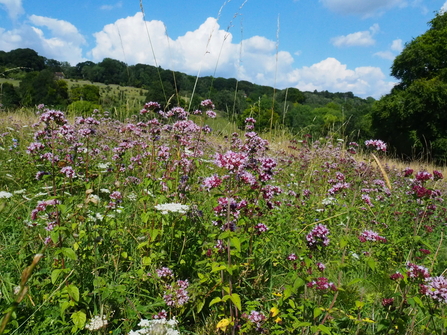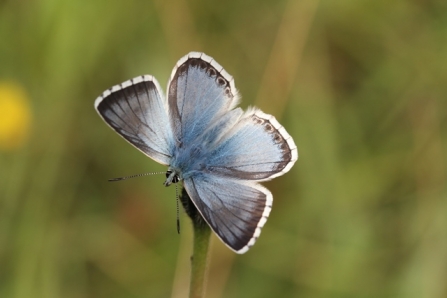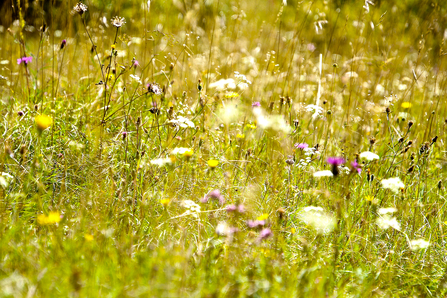
Chalk grassland flowers at Dancersend. Photo by Mick Jones
Yoesden nature reserve by Jacqui Titcombe

Chalk grassland flowers at Dancersend. Photo by Mick Jones
Dancersend, once owned by the Rothschild family, was made a nature reserve in the 1940s in remembrance of Charles Rothschild, the founder of UK nature conservation. You can learn more about its history here.
In late summer the chalk grassland is buzzing with insects which feed on the wide variety of flowers. Beyond the grassland the extensive woodland provides cool shade on hot summer days.
Last year BBOWT was successful in gaining two years funding from the Rothschild Foundation for a whole range of enhancements at Dancersend reserve. There are lots of events at the reserve in August to showcase the wildlife that lives here. Come and join us to learn more about this special place for conservation.

Jim Asher
Dry Sandford Pit is a fascinating mosaic of fossil-rich cliffs, fenland with ponds and streams, grassland, scrub and woodland set in an old quarry. It's one of several nature reserves within the Cothill Fen that BBOWT cares for.
The exposed layers of Dry Sandford Pit's low sand and limestone cliffs illustrate the various stages as the sea that once covered Oxfordshire receded. The cliffs contain many corals and visible fossils of marine creatures dating back to the Jurassic era. Because of this, the area is protected by law and it's illegal to damage, dig or remove any stones or fossils found here.
The cliff faces are very important for wildlife too. Restoration work has cleared away scrub from these cliffs and trees have been coppiced. Solitary bees and wasps, including the five-banded tailed digger wasp, have burrowed into the soft sandy layers creating a honeycomb of tiny holes.

Nationally important for its archaeology as well as its wildlife, Seven Barrows in West Berkshire is an ancient and atmospheric site with a wonderful variety of chalk grassland flowers and butterflies in summer.
Until comparatively recently, such flower-rich chalk grassland was widespread over the Downs, but now few wildlife havens are left because of intensive farming. This area probably survived because the barrows make it physically difficult to plough the land.
More than 150 plant species have been recorded on this old chalk grassland including horseshoe vetch, chalk milkwort, chalk fragrant-orchid, the delicate blue harebell and the purple-blue clustered bellflower. Its notable butterfly list includes the chalkhill blue, small blue, brown argus, marbled white and small heath.

Sydlings Copse by Colin Williams
The diversity of this small nature reserve on the edge of Oxford is quite staggering. Boasting ancient broadleaved woodland, limestone grasslands, reedbed, fen and a stream, the reserve supports over 400 plant species.
The site is also teeming with birds and insect life; butterflies include the purple hairstreak, brown hairstreak, common blue and marbled white. Follow the badger waymarkers which take you on a short circular walk around the reserve.

Chalkhill blue by Colin Williams
This small reserve on a steep southwest slope is part of a larger wildlife site named after the adjacent track from Lambourn, the White Shute Byway. Fragments of wildflower-rich chalk grassland, like Watts Bank, have usually survived because they are situated on a hill or earthworks which are unsuitable for ploughing.
This grassland hillside is a natural sun trap, sheltered from wind by patches of scrub at each corner. It is very attractive to butterflies, with an impressive 32 species recorded, including chalkhill blue, green hairstreak, brown argus and dingy skipper. They fly amongst the wild flowers and at least 16 species of grass including quaking-grass, whose purplish-green flowers dance delicately in the breeze.

Yoesden nature reserve by Jacqui Titcombe
Situated in the Radnage valley, Yoesden is a beautiful example of the traditional Chiltern landscape in south Buckinghamshire. A swathe of chalk grassland undamaged by ploughing, fertilisers and intensive grazing is packed with rare butterflies and wild flowers and is topped by a ‘hanger’ woodland of beech, yew and whitebeam trees on the edge of a steeply sided valley.
Twenty eight species of butterfly have been recorded here including three scarce blue species: Adonis, chalkhill and small blue butterflies, all of which rely on the flower-rich grassland that makes up about half of the reserve.
Late in the summer the colours change to a much deeper purple with carpets of Devil’s-bit scabious, knapweed and Chiltern gentians starting to dominate areas of the grassland.

Yoesden nature reserve by Jacqui Titcombe
Follow us on Instagram for photos and videos of seasonal wildlife from across our three counties. Tag us in your posts too! We love seeing the wildlife you've spotted and where you've been exploring.
@BBOWT #BBOWT